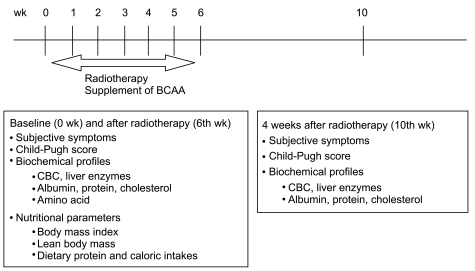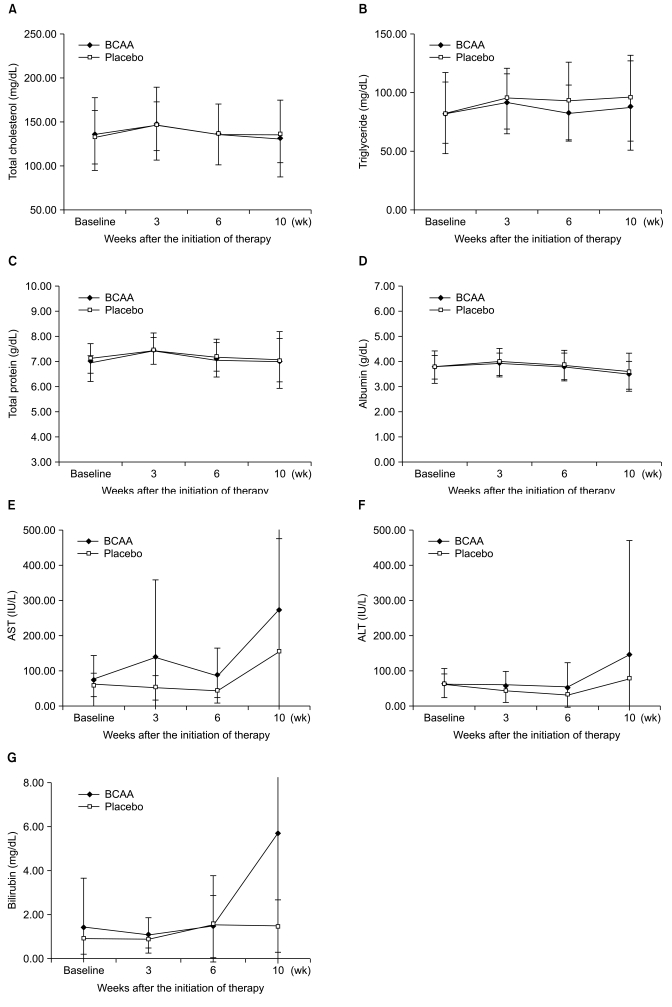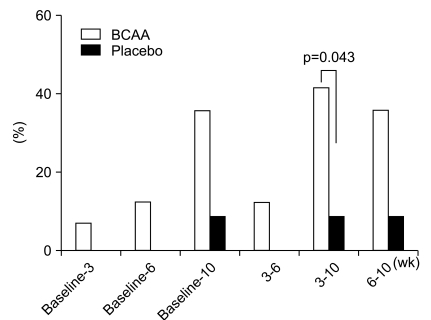Cancer Res Treat.
2011 Mar;43(1):24-31.
Effect of Oral Supplementation with Branched-chain Amino Acid (BCAA) during Radiotherapy in Patients with Hepatocellular Carcinoma: A Double-Blind Randomized Study
- Affiliations
-
- 1Department of Radiation Oncology, Yonsei University Health System, Seoul, Korea. jsseong@yuhs.ac
- 2Department of Internal Medicine, Yonsei University Health System, Seoul, Korea.
- 3Department of Food and Nutrition, Yonsei University College of Human Ecology, Seoul, Korea.
Abstract
- PURPOSE
The present study evaluated whether oral supplementation with a branched-chain amino acid (BCAA) improves the biochemical and amino acid profiles of liver tumor patients undergoing radiotherapy.
MATERIALS AND METHODS
Patients were randomly assigned to one of 2 groups: a group given oral supplementation with BCAA granules (LIVACT granules; Samil Pharm Co., Korea, each granule containing L-isoleucine 952 mg, L-leucine 1,904 mg, and L-valine 1,144 mg) during radiotherapy, or a placebo group. Physical and biochemical examinations and measurements, including subjective symptoms, Child-Pugh class, body mass index, plasma albumin concentration, and plasma amino acid profiles were monitored.
RESULTS
Fifty were enrolled between November 2005 and November 2006. We also analyzed data from 37 hepatocellular carcinoma (HCC) patients in order to evaluate a more homogenous group. The two groups of patients were comparable in terms of age, gender, Child-Pugh score, and underlying hepatitis virus type. Serum albumin, total protein, liver enzymes, and cholesterol showed a tendency to increase in the BCAA group. In this group, the percentage of cases that reverted to normal serum albumin levels between 3 and 10 weeks after administration of BCAA was significantly higher (41.18%) than in the placebo group (p=0.043).
CONCLUSION
Oral supplementation with a BCAA preparation seems to help HCC patients undergoing radiotherapy by increasing the BCAA concentration.
MeSH Terms
Figure
Reference
-
1. el-Serag HB. Epidemiology of hepatocellular carcinoma. Clin Liver Dis. 2001; 5:87–107. viPMID: 11218921.
Article2. Annual report on the cause of death statistics [Internet]. 2009. cited 2010 Mar 4. Daejeon: Korea National Statistical Office;Available from: http://www.kosis.kr .3. Poon RT, Fan ST, Tsang FH, Wong J. Locoregional therapies for hepatocellular carcinoma: a critical review from the surgeon's perspective. Ann Surg. 2002; 235:466–486. PMID: 11923602.
Article4. Cochrane AM, Murray-Lyon IM, Brinkley DM, Williams R. Quadruple chemotherapy versus radiotherapy in treatment of primary hepatocellular carcinoma. Cancer. 1977; 40:609–614. PMID: 196734.
Article5. Ingold JA, Reed GB, Kaplan HS, Bagshaw MA. Radiation hepatitis. Am J Roentgenol Radium Ther Nucl Med. 1965; 93:200–208.6. Lawrence TS, Tesser RJ, ten Haken RK. An application of dose volume histograms to the treatment of intrahepatic malignancies with radiation therapy. Int J Radiat Oncol Biol Phys. 1990; 19:1041–1047. PMID: 2211241.
Article7. Emami B, Lyman J, Brown A, Coia L, Goitein M, Munzenrider JE, et al. Tolerance of normal tissue to therapeutic irradiation. Int J Radiat Oncol Biol Phys. 1991; 21:109–122. PMID: 2032882.
Article8. Lawrence TS, Ten Haken RK, Kessler ML, Robertson JM, Lyman JT, Lavigne ML, et al. The use of 3-D dose volume analysis to predict radiation hepatitis. Int J Radiat Oncol Biol Phys. 1992; 23:781–788. PMID: 1618671.
Article9. Robertson JM, McGinn CJ, Walker S, Marx MV, Kessler ML, Ensminger WD, et al. A phase I trial of hepatic arterial bromodeoxyuridine and conformal radiation therapy for patients with primary hepatobiliary cancers or colorectal liver metastases. Int J Radiat Oncol Biol Phys. 1997; 39:1087–1092. PMID: 9392548.
Article10. Seong J, Keum KC, Han KH, Lee DY, Lee JT, Chon CY, et al. Combined transcatheter arterial chemoembolization and local radiotherapy of unresectable hepatocellular carcinoma. Int J Radiat Oncol Biol Phys. 1999; 43:393–397. PMID: 10030267.
Article11. Park W, Lim DH, Paik SW, Koh KC, Choi MS, Park CK, et al. Local radiotherapy for patients with unresectable hepatocellular carcinoma. Int J Radiat Oncol Biol Phys. 2005; 61:1143–1150. PMID: 15752895.
Article12. Shim SJ, Seong J, Han KH, Chon CY, Suh CO, Lee JT. Local radiotherapy as a complement to incomplete transcatheter arterial chemoembolization in locally advanced hepatocellular carcinoma. Liver Int. 2005; 25:1189–1196. PMID: 16343071.
Article13. Lee IJ, Seong J, Shim SJ, Han KH, Chon CY. Reappraisal of risk factors predicting liver complications from radiotherapy for hepatocellular carcinoma. Korean J Hepatol. 2006; 12:420–428. PMID: 16998294.14. Cheng JC, Wu JK, Huang CM, Huang DY, Cheng SH, Lin YM, et al. Radiation-induced liver disease after radiotherapy for hepatocellular carcinoma: clinical manifestation and dosimetric description. Radiother Oncol. 2002; 63:41–45. PMID: 12065102.
Article15. Liang SX, Zhu XD, Xu ZY, Zhu J, Zhao JD, Lu HJ, et al. Radiation-induced liver disease in three-dimensional conformal radiation therapy for primary liver carcinoma: the risk factors and hepatic radiation tolerance. Int J Radiat Oncol Biol Phys. 2006; 65:426–434. PMID: 16690430.
Article16. Nompleggi DJ, Bonkovsky HL. Nutritional supplementation in chronic liver disease: an analytical review. Hepatology. 1994; 19:518–533. PMID: 8294109.
Article17. Fan ST, Lo CM, Lai EC, Chu KM, Liu CL, Wong J. Perioperative nutritional support in patients undergoing hepatectomy for hepatocellular carcinoma. N Engl J Med. 1994; 331:1547–1552. PMID: 7969324.
Article18. Meng WC, Leung KL, Ho RL, Leung TW, Lau WY. Prospective randomized control study on the effect of branched-chain amino acids in patients with liver resection for hepatocellular carcinoma. Aust N Z J Surg. 1999; 69:811–815. PMID: 10553972.
Article19. Muto Y, Yoshida T, Sato S, Suzuki K, Okada H, Hayashi S, et al. Effect of oral administration with branched-chain amino acid granules (BCAA-G) in patients with liver cirrhosis: a clinical study. JJPEN. 1989; 11:1119–1134.20. Lee IJ, Seong J, Shim SJ, Han KH. Radiotherapeutic parameters predictive of liver complications induced by liver tumor radiotherapy. Int J Radiat Oncol Biol Phys. 2009; 73:154–158. PMID: 18823715.
Article21. Marchesini G, Bianchi G, Merli M, Amodio P, Panella C, Loguercio C, et al. Nutritional supplementation with branched-chain amino acids in advanced cirrhosis: a double-blind, randomized trial. Gastroenterology. 2003; 124:1792–1801. PMID: 12806613.
Article22. Song KH, Kim MS, Han KH, Lee KS, Chon CY, Moon YM, et al. Prospective study on efficacy of oral supplement of branched-chain amino acid granules on the nutritional status of the cirrhotics. Korean J Hepatol. 2001; 7:432–438.23. Nijveldt RJ, Wiezer MJ, Meijer C, Prins HA, Statius Muller MG, Gouma DJ, et al. Major liver resection results in a changed plasma amino acid pattern as reflected by a decreased Fischer ratio which improves by bactericidal/permeability increasing protein. Liver. 2001; 21:56–63. PMID: 11169074.
Article
- Full Text Links
- Actions
-
Cited
- CITED
-
- Close
- Share
- Similar articles
-
- Prospective Study on Efficacy of Oral Supplement of Branched-Chain Amino Acid Granules on the Nutritional Status of the Cirrhotics
- Nutritional management and branched-chain amino acids diet among patients undergoing living donor liver transplantation
- Effects of Nutritional Supplementation on Nutirtional Status in Patients with Nonalcoholic Liver Cirrhosis
- Association between dietary branchedchain amino acid intake and skeletal muscle mass index among Korean adults: Interaction with obesity
- Role of Branched-chain Amino Acid Metabolism in Tumor Development and Progression




